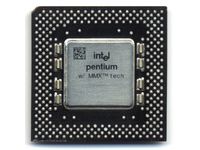The Return of Intel's Pentium MMX
Mountain House (CA) - Earlier today we learned that Intel is already heavily pitching its Larrabee technology to partners, but the technology foundation largely remains a mystery. German publication heise.de now provides more clues with a rather interesting note that Larrabee is built on Intel’s nearly two decade-old P5 architecture.
According to Heise author Andreas Stiller, possibly the most prominent person to cover computer hardware in Germany, Intel dipped into the bin of obsolete technology (Intel’s phrase for replaced technology) to come up with a technology base for the Larrabee cGPU. While attending Intel’s 40th anniversary briefing (Intel will celebrate its 40th birthday on July 18), Stiller apparently found out that the Larrabee cores will be built on the P54C core — which was the code-name for the second-gen, 600 nm Pentium chip.
The first Pentium core (P5, 800 nm, 60 and 66 MHz) was in development since 1989 and was introduced in 1993. The P54C was launched in 1994 with speeds up to 120 MHz, while the succeeding 350 nm P54CS reached 200 MHz. The 55C core (280 nm up to 233 MHz) followed in 1995 and was replaced with the Pentium II in 1997.
Stiller added that Larrabee will debut with 32 cores that "are likely" to be equipped with MMX extensions, which would mean that Larrabee will actually be based on a modified, 45 nm P54CS core. The cores will also support 64-bit. If you count in the fact that the MMX part was replaced with a 512-bit wide AVX (Advanced Vector Extensions) unit, Stiller comes up with a theoretical performance of 32 flop/sec. per clock, topping the 2 Tflop/sec. mark at a clock speed of 2 GHz.
If this is true, then Intel may be able to hit about twice the performance in single precision calculations as Nvidia and AMD achieve today. However, both Nvidia and AMD were able to double their floating point performance between 2007 and 2008 and we have reason to believe that once Larrabee will be available, GPUs may be hitting 3 to 4 Tflop/sec. in single GPU configurations. AMD’s dual-GPU ATI Radeon 4870 X2 (clocked at 778 MHz) is estimated to hit 2.49 Tflop/sec. when it debuts within the next few weeks.
It looks like that Intel should be aiming for at least 4 Tflop/sec. for the second half of 2009.
Get Tom's Hardware's best news and in-depth reviews, straight to your inbox.
-
jcwbnimble Interesting that intel is going back almost 20 years to try and compete with Nvidia and AMD/ATI's current (or near future) technologies. That would be great if we could get one more player in the GPU market. AMD is forcing Nvidia to lower their prices, can you imagine what Intel could do if they introduced a 3rd GPU in the market? SWEET!Reply -
jimmysmitty thogrom Core 2 is based off of Core which goes all the way back to the Pentium Pro which had its roots from the Pentium MMX. So in a way it is based off of the same technology that Core 2 is based off of.Reply
Funny thing, kinda related, I have a old Pentium w/MMX sitting on my desk. Its a reminder of where we used to be (75 whole MHz YAY!!!!) -
plbyrd This is very good news. For years I've been saying that Intel should dust off the 386 and put dozens of them on a single die. It looks like they've done me one better and gone with the Pentium. This is a very smart move for Intel because it accomplishes three things:Reply
1) They don't have to develop a new core for the cGPU.
2) The cGPU will use x86/x64 instructions, thus making it far easier for developers to write code and debug code targeting the cGPU.
3) Developers will learn to employ proper threading techniques to utilizes 32 cores. This means they'll learn the skills necessary to truly take advantage of the modern CPUs.
A side effect of all this is that a computer built solely around the Larrabee. Over on my blog at ITtoolbox I've pontificated about the possibility of building GPU-based computers, and this could be a great place to start. -
Definitely it will run x86 because it was developed on x86 architecture. If Intel will manage to develop and make it a powerful GPU, it simply means that powerful GPU was already develop 2 decades ago but only used for general purpose computing.Reply
-
harrycat88 LMAO, I still got my old Pentium 233MHz MMX Socket 7 CPU. Can you believe I got that thing to over clock to 333MHz back in 1998. I ran a duct from outside which was 20 degrees F to the CPU. It would scream through Quake2 and Tomb Raider 2 which was fast back then, But today the CPU is obsolete unless you want to run windows 98 or 2000. Who would have thought that Intel would use the design for a GPU.Reply
